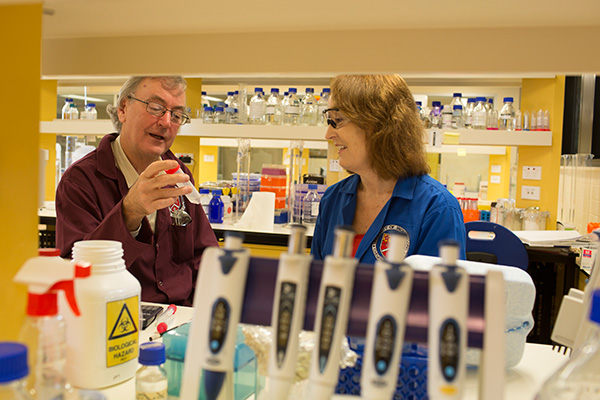November 18, 2014
Researchers say beautiful protein may be nasty to bacteria
An international team of researchers have discovered an important new drug target in the battle against antibiotic-resistant bacteria.

Professor Nick Dixon (pictured left) is Professor of Biological Chemistry and Director of the Centre for Medical and Molecular Bioscience at UOW.
Researchers in UK, Sydney and Wollongong have presented, for the first time, detailed structural information on a protein that plays a crucial role in cell division in pathogenic bacteria such asStaphylococcus aureus (‘golden staph’), representing an important new drug target in the battle against antibiotic-resistant bacteria.
Led by Professor Richard Lewis from Newcastle University’s Institute for Cell and Molecular Biosciences (UK), the study, published in Nature Communications on 18 November, involved some of the world’s leading structural/cell biologists including Professor Elizabeth Harry from the University of Technology Sydney and Professor Nick Dixon and Associate Professor Aaron Oakley from the Illawarra Health and Medical Research Institute, based on the UOW campus.
Using complementary approaches, the researchers studied the structure and function of ‘EzrA’, a membrane protein component of the molecular machine known as the divisome, which assembles in the centre of cells and causes the cell wall to constrict like an iris to separate the two ‘daughter’ cells at cell division.
EzrA displayed an unusual and beautiful semi-circular structure with similarities to the ubiquitous proteins known as spectrins, which are involved in the organisation of cytoskeleton and membrane processes in higher organisms including humans. While spectrins display an elongated molecular shape due to multiple connected repeats of three anti-parallel helices which curve and coil around each other, EzrA is formed from a series of five spectrin-like repeats.
This unusual shape enables EzrA to interact with adjacent membrane-bound divisome components, with the researchers identifying at least two binding sites and map regions responsible for regulating these interactions.
Cartoon representation of the 3D structure of EzrA. It has five repeats of three-helix bundles called spectrin repeats.
EzrA not only has the same structure as spectrins, but in Nature Communications the researchers propose that it is, in fact, the founding member of a new family of bacterial spectrin-like proteins and plays a key role both as a regulator of cell division and in the maintenance of cell size and shape.
“We propose a role for EzrA that is analogous to that of spectrins in eukaryotes, linking the dynamics of the bacterial cytoskeleton to the membrane-anchored components of the divisome,” explained Professor Dixon.
“Because EzrA interacts with many other proteins in the divisome and cell division is absolutely necessary for bacteria to survive, it seems to be an excellent target for development of new antibacterial drugs against staph infections. If we could prevent the interactions of EzrA with these other proteins, we could prevent the bacteria from dividing and causing infections in humans.”
The international collaboration is the result of relationships built over more than a decade, with work in the Dixon, Oakley and Harry laboratories previously funded by the National Health and Medical Research Council (Australia), while work in the Lewis laboratory is currently funded by the Biotechnology and Biological Sciences Research Council (UK).
From here the researchers will continue working together to dissect the other protein interactions that EzrA participates in.
“Structure and function of a spectrin-like regulator of bacterial cytokinesis” was published on 18 November, 2014, in Nature Communications.
Media contacts: Professor Nick Dixon is available for interview on + 61 2 4221 4346 or nickd@uow.edu.au. For more information, contact IHMRI Communications Coordinator, Robyn Gower on + 61 2 4252 8228 or rgower@uow.edu.au.